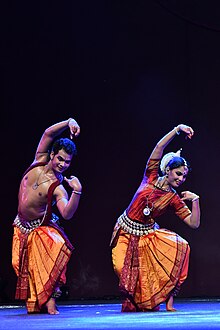
Back أوديسي Arabic اوديسى (رقصه) ARZ ওডিছী নৃত্য Assamese ওড়িশি Bengali/Bangla Odissi German Odissi Spanish اریسی Persian Odissi Finnish Odissi French ओडिसी नृत्य GOM
 Odissi | |
| Native name | ଓଡ଼ିଶୀ (Odia) |
|---|---|
| Genre | Indian classical dance |
| Origin | Odisha, India |
Odishi (Odia: ଓଡ଼ିଶୀ), also referred to as Orissi in old literature, is a major ancient Indian classical dance that originated in the temples of Odisha – an eastern coastal state of India.[1][2][3] Odissi, in its history, was performed predominantly by women,[1][4] and expressed religious stories and spiritual ideas, particularly of Vaishnavism through songs written and composed according to the ragas & talas of Odissi music by ancient poets of the state. Odissi performances have also expressed ideas of other traditions such as those related to Hindu deities Shiva and Surya, as well as Hindu goddesses (Shaktism).[5]
The theoretical foundations of Odissi trace to the ancient Sanskrit text Natya Shastra, its existence in antiquity evidenced by the dance poses in the sculptures of Kalingan temples,[1][6] and archeological sites related to Hinduism, Buddhism and Jainism.[7][8][9] It was suppressed under the British Rule.[10][11] The suppression was protested by the Indians, followed by its revival, reconstruction and expansion since India gained independence from the colonial rule.[8]
Odissi is traditionally a dance-drama genre of performance art, where the artist(s) and musicians play out a story, a spiritual message or devotional poem from the Hindu texts, using symbolic costumes,[12] body movement, abhinaya (expressions) and mudras (gestures and sign language) set out in ancient Sanskrit literature.[13] Classical Odia literature & the Gita Govinda set to traditional Odissi music are used for the abhinaya. Odissi is learnt and performed as a composite of basic dance motif called the Bhangas (symmetric body bends, stance). It involves lower (footwork), mid (torso) and upper (hand and head) body as three sources of perfecting expression and audience engagement with geometric symmetry and rhythmic musical resonance.[14][15] An Odissi performance repertoire includes invocation, nritta (pure dance), nritya (expressive dance), natya (dance drama) and moksha (dance climax connoting salvation of the soul and spiritual release).[16][17]
Traditional Odissi exists in two major styles, the first perfected by women and focussed on solemn, spiritual temple dance (maharis); the second perfected by boys dressed as girls (gotipuas)[18] which diversified to include athletic and acrobatic moves, and were performed from festive occasions in temples to general folksy entertainment.[6] Modern Odissi productions by Indian artists have presented a diverse range of experimental ideas, culture fusion, themes and plays.[19]
Odissi was the only Indian dance form present in Michael Jackson's 1991 hit single Black or White.
- ^ a b c Odissi Encyclopædia Britannica (2013)
- ^ Williams 2004, pp. 83–84, the other major classical Indian dances are: Bharatanatyam, Kathak, Kuchipudi, Kathakali, Manipuri, Chhau, Satriya, Yaksagana and Bhagavata Mela.
- ^ "Guidelines for Sangeet Natak Akademi Ratna and Akademi Puraskar". Archived from the original on 14 October 2013. Retrieved 6 November 2013.
- ^ Peter J. Claus; Sarah Diamond; Margaret Ann Mills (2003). South Asian Folklore: An Encyclopedia. Routledge. p. 136. ISBN 978-0-415-93919-5.
- ^ Sunil Kothari; Avinash Pasricha (1990). Odissi, Indian classical dance art. Marg Publications. pp. 4–6, 41. ISBN 978-81-85026-13-8., Quote: "There are other temples too in Odisha where the maharis used to dance. Besides the temple of Lord Jagannatha, maharis were employed in temples dedicated to Shiva and Shakti."
- ^ a b James G. Lochtefeld (2002). The Illustrated Encyclopedia of Hinduism: N-Z. The Rosen Publishing Group. pp. 484–485. ISBN 978-0-8239-3180-4.
- ^ Richard Schechner (2010). Between Theater and Anthropology. University of Pennsylvania Press. pp. 65–66. ISBN 978-0-8122-0092-8.
- ^ a b Evangelos Kyriakidis (2007). The archaeology of ritual. Cotsen Institute of Archaeology, University of California Press. pp. 155–158. ISBN 978-1-931745-48-2.
- ^ Sunil Kothari; Avinash Pasricha (1990). Odissi, Indian classical dance art. Marg Publications. pp. 9–10, 12. ISBN 978-81-85026-13-8., Quote: The art of dance and maasic suffered on account of political instability, the Muslim invasion, the desecration of the temples and the loss of independence, the lack of patronage to both the maharis and the gotipua dancers..."
- ^ Ragini Devi 1990, pp. 47–49.
- ^ Alexandra Carter (2013). Rethinking Dance History: A Reader. Routledge. pp. 144–145. ISBN 978-1-136-48500-8.
- ^ Stephanie Arnold (2014). The Creative Spirit: An Introduction to Theatre. McGraw Hill. p. 9. ISBN 978-0-07-777389-2.
- ^ Sunil Kothari; Avinash Pasricha (1990). Odissi, Indian classical dance art. Marg Publications. pp. 1–4, 76–77. ISBN 978-81-85026-13-8.
- ^ Sunil Kothari; Avinash Pasricha (1990). Odissi, Indian classical dance art. Marg Publications. p. 50. ISBN 978-81-85026-13-8.
- ^ Kapila Vatsyayan (1983). The square and the circle of the Indian arts. Roli Books International. pp. 57–58.
- ^ Cite error: The named reference
NettlStone1998p520was invoked but never defined (see the help page). - ^ Cite error: The named reference
aroyo267was invoked but never defined (see the help page). - ^ Axel Michaels; Christoph Wulf (2012). Images of the Body in India: South Asian and European Perspectives on Rituals and Performativity. Routledge. p. 192. ISBN 978-1-136-70392-8.
- ^ Ian Watson (2003). Towards a Third Theatre: Eugenio Barba and the Odin Teatret. Routledge. pp. xii–xiii. ISBN 978-1-134-79755-4.
© MMXXIII Rich X Search. We shall prevail. All rights reserved. Rich X Search